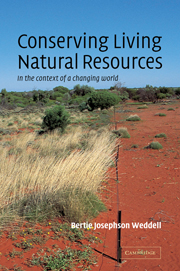Book contents
- Frontmatter
- Contents
- Preface
- Introduction: Balance and flux
- Methodology: Getting the information we need to manage living natural resources
- Part I Management to maximize production of featured species – a utilitarian approach to conservation
- 1 Historical context – the commodification of resources and the foundations of utilitarian resource management
- 2 Central concepts – population growth and interactions between populations
- 3 Central concepts – habitats
- 4 Techniques – harvest management
- 5 Techniques – habitat management
- 6 Techniques – management to minimize conflicts between pest species and people
- Part II Protection and restoration of populations and habitats – a preservationist approach to conservation
- Part III Management to maintain processes and structures – a sustainable-ecosystem approach to conservation
- Postscript
- Appendix: Scientific names of organisms mentioned in the text
- Index
6 - Techniques – management to minimize conflicts between pest species and people
Published online by Cambridge University Press: 05 June 2012
- Frontmatter
- Contents
- Preface
- Introduction: Balance and flux
- Methodology: Getting the information we need to manage living natural resources
- Part I Management to maximize production of featured species – a utilitarian approach to conservation
- 1 Historical context – the commodification of resources and the foundations of utilitarian resource management
- 2 Central concepts – population growth and interactions between populations
- 3 Central concepts – habitats
- 4 Techniques – harvest management
- 5 Techniques – habitat management
- 6 Techniques – management to minimize conflicts between pest species and people
- Part II Protection and restoration of populations and habitats – a preservationist approach to conservation
- Part III Management to maintain processes and structures – a sustainable-ecosystem approach to conservation
- Postscript
- Appendix: Scientific names of organisms mentioned in the text
- Index
Summary
In the utilitarian perspective on resource management, species are viewed as either good or bad. We have already seen how populations and habitats can be managed to favor species that are considered valuable. This chapter considers how utilitarian resource managers attempt to control populations of species that are considered overabundant. It begins with a consideration of the why and how of control efforts, then provides some historical background, and concludes by examining five case studies.
What is a pest?
Plants and animals that are perceived as detrimental to people or their interests are considered pests. Pests can be plants, fungi, invertebrates, fish, amphibians, reptiles, birds, or mammals. This chapter will emphasize attempts to control vertebrates that have been considered overabundant; insects and plant pests will be touched on only briefly. (See Chapter 5 for information about attempts to control woody vegetation on North American rangelands and Chapter 7 for a discussion of the ecological effects of chemicals used to control plants and insects.)
There are two main reasons why a species may be considered a pest: because it causes economic damage (directly, by killing a valued species or damaging property, or indirectly, by competing with valued species for limiting resources) or because it poses a threat to the health and safety of people or domestic animals.
- Type
- Chapter
- Information
- Conserving Living Natural ResourcesIn the Context of a Changing World, pp. 143 - 160Publisher: Cambridge University PressPrint publication year: 2002



